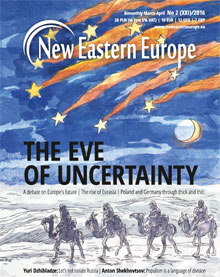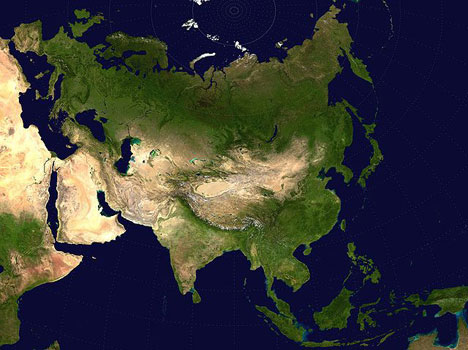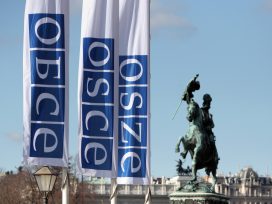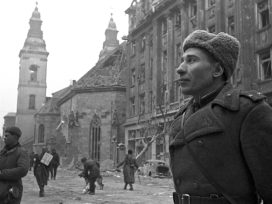 This year marks the 25th anniversary of the collapse of the Soviet Union, the main geopolitical tragedy of the twentieth century according to Russia’s president, Vladimir Putin. Even though the political situation in the region has changed dramatically in the last 25 years, the term “post-Soviet” is still being used to define the geopolitical space between the European Union, China, the Indian Peninsula and the Middle East. This post-Soviet paradigm, which unjustly preserves a conviction about Moscow’s role as a sun around which the post-Soviet planets orbit, is already out-dated. Naturally, Russia is and will remain the key continental power in this geopolitical space. However, its influence in the “near abroad”, to use Kremlin terminology, has decisively weakened since the collapse of the Soviet Union. Conversely, the importance of other actors (especially the United States, the EU, China, Turkey and Iran) has noticeably increased. Paradoxically, the more Russia tries to maintain its influence, the more outdated the term “post-Soviet space” becomes. Russia’s policies are coming up against increasing levels of resistance in its former colonies, which are searching for support elsewhere.
This year marks the 25th anniversary of the collapse of the Soviet Union, the main geopolitical tragedy of the twentieth century according to Russia’s president, Vladimir Putin. Even though the political situation in the region has changed dramatically in the last 25 years, the term “post-Soviet” is still being used to define the geopolitical space between the European Union, China, the Indian Peninsula and the Middle East. This post-Soviet paradigm, which unjustly preserves a conviction about Moscow’s role as a sun around which the post-Soviet planets orbit, is already out-dated. Naturally, Russia is and will remain the key continental power in this geopolitical space. However, its influence in the “near abroad”, to use Kremlin terminology, has decisively weakened since the collapse of the Soviet Union. Conversely, the importance of other actors (especially the United States, the EU, China, Turkey and Iran) has noticeably increased. Paradoxically, the more Russia tries to maintain its influence, the more outdated the term “post-Soviet space” becomes. Russia’s policies are coming up against increasing levels of resistance in its former colonies, which are searching for support elsewhere.
Lost potential
This situation leads to a waste of Russian potential and hinders the Kremlin’s activities aimed at counteracting the influence of “foreign powers”. Today, Russia itself is the target of EU, Chinese and Middle Eastern influence. Russia has limited opportunity to shape the policies of these players, a point that was painfully illustrated by the rapid decrease in oil prices supported by the states in the Persian Gulf, the imposition of western sanctions and the conclusion of contracts with China, the terms of which were unfavourable for Russia.
The need to change this paradigm is not just a result of the anniversary of the Soviet Union’s collapse. It also stems from the fact that in recent years, all these processes have rapidly accelerated. In 2013 it became clear that the existing post-Soviet model of economic, social and political development was entering into decline. It was then that the current economic crisis affecting Russia, which hit the former colonies, began. In November 2013 Ukrainians started their Revolution of Dignity in Kyiv. These events later developed according to Hitchcock’s rule: “A good film should start with an earthquake and be followed by rising tension.” There is no doubt that the protests that took place in Kyiv between 2013-2014 caused Ukrainians to turn towards the EU and thus led to Russia’s aggression in Ukraine. Russia, in conflict with the West, decisively approached China, which further worsened the conditions that the more powerful Beijing decided to dictate. The system of communicating vessels deepened. Increased Chinese influence in Russia translated into China strengthening its position in the whole post-Soviet space, particularly Central Asia. The stronger China’s position in Russia’s neighbourhood is, the greater its field of manoeuvre towards Moscow.

A satellite image homing in on Eurasia (based on an image from NASA’s Blue Marble project). Photo: Mdf. Source: Wikimedia
The main tool facilitating China’s expansion into Eurasia is its new, ambitious plan to establish a new economic trading belt, dubbed the “new Silk Road”. Its creation was announced by China’s president in September 2013, during a visit to Kazakhstan. Beijing has already allocated significant resources to implement it. The concept of the new Silk Road is the creation of a network of transport corridors that would connect China with the EU. This would mean the construction or modernisation of transportation links such as rail (including fast rail) and roads, as well as the creation of a stronger energy infrastructure and telecommunications network.
The foundation of the new Silk Road abolishes the old post-Soviet paradigm. New pathways will connect the Caucasus, Central Asia and Eastern Europe with the Middle East, the Balkans and Central Europe. The blurring of borders between the post-Soviet space and its neighbourhood has also been confirmed by a decision made in July 2015 by the Shanghai Co-operation Organisation, a body established by the Central Asian countries (without Turkmenistan), Russia and China to accept India and Pakistan to join their group. Quite soon, this may also be joined by Iran, which has recently been freed from international sanctions.
Central Eurasia
Russia’s military intervention in Syria is an even more explicit indication that a new Eurasian geopolitical space is emerging. This was the first military operation undertaken by Russia outside the post-Soviet space since the Soviet-Afghan War in 1979. It is also important to note that, among Bashar al-Assad’s opponents, there are at least a few thousand fighters from the former Soviet Union. One of them is Omar Al-Shishani, a half-Chechen, half-Georgian fighter who is the commander of the military forces of the Islamic State in Syria.
The phenomena that have been mentioned above are only likely to deepen in the oncoming decades. Furthermore, they will be most likely accompanied by an increase in the deeply diverse Muslim population. Quite soon, there will be more Muslims in the post-Soviet space than ethnic Russians. Therefore, these processes are creating a need to redefine the post-Soviet space (including Russia), together with its neighbouring regions. A better name for these territories would be Central Eurasia, which would be used in reference to the geopolitical space between China and the European Union which, to a large extent, is an integral part of a deeply diverse Muslim world. Such a redefinition will mean that Central Eurasia becomes, after the Pacific and the Atlantic, the third most important region in the world, where the biggest global actors and regional powers interact.
The territory of Central Eurasia is organised around the Great Steppe, the largest prairie flatland in the world, which spreads from the Carpathians to Korea and smoothly forms part of its neighbouring regions. Therefore, the emerging new order in Eurasia is largely a recreation of traditional historical ties (such as the “wider” version of Central Asia, which is made up of Kazakhstan, Kirgizstan, Turkmenistan, Uzbekistan, Tajikistan, Azerbaijan, a “Greater” Mongolia that includes the Russian republics of Buryatia, Tyva, Altai and the Chinese regions of Xinijang and Qinghai, northern Afghanistan, north-eastern Iran, the Volga Region, the Caucuses, Iran, Turkey, Manchuria, north-western China and the Russian Far East, as well as the Black Sea region, which includes Ukraine, the Balkans and Moldova).
Today, the term “Eurasia” has been hijacked by Russia, who use it in the “Eurasian Economic Union”. As a result, the name now has purely negative connotations in the West. Nonetheless, we should use it in a more neutral geographical manner and not treat it as an axiological term. What is more, Europe’s position on the global stage will, to a great extent, depend on its ability to accept its own belonging to Eurasia and engagement in the geopolitical and economic games which go beyond its southern and eastern neighbourhoods, perceiving the latter as an integral part of a greater whole. If the European Union wants to remain relevant in global affairs, it needs to be active along the whole new Silk Road and define its eastern policy as a policy towards Eurasia, one that goes beyond relations with Russia and the former Soviet republics and is instead aimed primarily at China, Turkey and Iran.
Cultural influences
Geopolitical changes in Eurasia, aside from their political and economic context, should also be considered from a cultural and historical perspective. The issue of identity is of primary importance. The new Silk Road project is deeply rooted in the history of Central Asia and closely linked with the Great Steppe. The latter has played an important role as a highway during the great migrations from Asia to Europe, the Middle East and India. In fact, the nomads from the Great Steppe established the largest territorial powers in the history of mankind. Consider the Mongol Empire stretching from the Baltic Sea to the Pacific Ocean, from Vietnam to Lake Baikal. Their global horizons were ahead of their time. The Great Steppe also had a large impact on different forms of culture (clothing, weapons, cuisine, games, values and vocabulary) on both sides of Eurasia, from Eastern Europe to the Far East. Without it, there would have been no Ukrainian Cossacks or sarmatism, which was a unique, deeply oriental part of Polish culture. Japanese samurai culture would also not have existed, shaped as it was by contact with Korea, which was connected with the Manchurian steppe.
It is possible to anecdotally define the borders of the Great Steppe’s influence by the places where people eat pierogi, a dish which comes from Central Asia. In this space, Russia is a newcomer. Its conquests are actually something quite novel. Russia conquered Belarus and most of Ukraine by the end of the 18th century, and added Moldova to this in the early 19th century. The conquest of the Caucuses ended in 1864, and that of Central Asia in the 1880s. It was in the 1850s and 1860s when China lost large chunks of territory to Russia in Central Asia, Siberia and the Far East.
Trade also developed at an unpreceded scale on the territories of the Great Steppe. This was an obvious precursor to our modern understanding of economic globalisation. The network of trade routes that connected Europe and the Middle East with China and India was later called the Silk Road. In Central Asia, it was divided into many branches: through Iran, the Caucuses, Turkey to the Balkans; through Iran, Iraq and onwards to the Middle East via the steppes of present day Russia and Ukraine to Central Europe and finally, through Afghanistan to the Indian Peninsula. For thousands of years, the Caucuses operated on an East-West axis, between the Black and Caspian Seas. Its history was shaped by empires located in Anatolia (Roman, Byzantine and Ottoman) and modern day Iran (the Parthian Empire, the Sasanian Empire and the Safavid Dynasty).
As a result, the Caucuses should be regarded as an integral element of the Middle East. It is no coincidence that Shota Rustaveli, the medieval Georgian author of the epic poem “The knight in the panther’s skin” called his work a Persian poem, basing his inspiration on Iranian literature. On the other hand, people from the Caucuses played an important role in the history of the Byzantine and the Ottoman Empires, as well as that of Iran and even the Arab world. A few of the most distinct Byzantine emperors (Hercalius II and Basil II) had Ottoman roots. From the 15th century until 1925, Iran was ruled by Azeri dynasties led by the Safavids. Even today, Iran is inhabited by more Azeri than Azerbaijan. As before, they are overrepresented among the ruling elite. For example, Ayatollah Khomeini was an Azeri. In the 16th and 17th centuries, when Iran was at the peak of its power, the Georgians and Armenians both played key roles; they created a district called New Julfa in Isfahan (central Iran). Its trade representations operated from Calcutta to Acapulco.
Eurasian dragon
Until the First World War, there were more Armenians in Turkey and Iran than there were in Russia. Turkey is responsible for a genocide that defined Armenian identity in the twentieth century. However, before this took place, the Armenians had for centuries made a huge contribution to the development of Turkish culture and were the authors of many influential novels, theatre plays, beautiful palaces and mosques. For centuries, the Turkish elite included people of Caucasian origin (Cherkess, Georgians and Abkhazians). Today, we can count famous writers (Orhan Pamuk) and influential politicians (Recep Tayyip Erdogan) amongst their ranks.
For centuries, Central Asia has been closely connected to the Middle East and China, but less so to Russia. It was also the cradle of the two largest civilisations in the history of the Muslim world, the Ottomans and the Mongols. It was Babur, from Fergana in Uzbekistan, who in the 16th century conquered the Indian Peninsula, creating the Great Mongol Empire. This also explains why the Muslim version of Hindi is called Urdu, which in Turkish means an army (ordu, hence the English word “horde”.
Central Asia was also religiously linked with the Middle East. It was home to Zarathustra, the founder of the Iranian religion to whom the three religions of Abraham (Judaism, Christianity, and Islam) owe their ideas about salvation, resurrection and heaven and hell. In the early Middle Ages, Central Asia became influenced by Christianity, which gave it the Mongolian alphabet and then Islam. The Muslims from Central Asia also contributed to the development of Islamic theology and mysticism. The latter was shaped by Buddhism, which at the time was very popular in Central Asia.
No state has as much potential and as many strong connections with Central Asia as China. For hundreds of years, China ruled, both directly and indirectly, over a large part of Siberia and Central Asia, which still bear clear traces of Chinese culture. A few of the most important dynasties ruling China had Mongolian, Manchurian and even Turkish, roots. The Qin dynasty, who gave China its name, depended on pro-Turkish people. One of the greatest emperors in the history of China was Kublai Khan (around 1215-1294), grandson of Genghis Khan. He ruled from the capital in Karakorum, then Beijing (called Khanbaliq, the capital of Khan), holding sway over the largest empire in the history of the world.
The empire of Genghis Khan was created on the foundations of the Mongolian-Chinese state of Qara Khitai, which brought the Chinese language, calligraphy and political system to Central Asia, combining them with steppe tradition. Belonging to the steppe tradition is a particularly important strand in China’s argument to play the leading role in Eurasia today. Russia, by slowly accepting the role of China as an older brother, also refers to its heritage of Mongol-Chinese rule. Dimitri Trenin, head of Carnegie Moscow, while explaining Russia’s point of view towards the West since its annexation of Crimea, described the Chinese-Russian alliance by comparing Putin to “one of the most revered Russian heroes from medieval history, Prince St. Alexander Nevsky, [who] successfully fought western invaders while remaining loyal to the Mongol khans”.
Better off together?
The deterioration in Russia’s relations with the West after its aggression towards Ukraine has led to an unprecedented rapprochement between Moscow and Beijing, accelerating processes which have been taking place for the last 20 years. Both countries talk about an alliance of “equal partners” who do not recognise the global dominance of the United States. However, it is an open secret that Washington and Beijing treat each other as first league super powers and see Russia as a second rank player. China’s involvement in Russia’s trade balance has been growing for many years now. Moreover, China has recently strengthened its position as Russia’s most important trade partner. In 2015 its share reached 12 per cent, while the EU’s share in Russian trade has been shrinking since 2013. Despite this increase, looking ahead, China will not be as important a trade partner for Russia as the entire EU. However, most probably China will strengthen its position of the most important economic state partner of Russia at the expense of EU countries.
Based on the estimations of the American Enterprise Institute and the Heritage Foundation, Chinese investments and contracts in Russia in 2013-2015 reached 18.5 billion US dollars. Before 2013 China would have needed over a decade to invest such sums in Russia. In May and November 2014 China and Russia signed two large energy agreements regarding the construction of two natural gas pipelines. In 2014 China became the main source of credit for the non-financial sector in Russia. Due to western sanctions, a few Russian banks began issuing bonds in Chinese yuan. Russian authorities also announced that by the middle of 2016, they would also start issuing state bonds. Co-operation in the sphere of security has also reached an unprecedented level. For example, Moscow has agreed to sell sophisticated S-400 anti-aircraft missiles and Su-35 fighter jets to Beijing. Furthermore, there has been a clear increase in the number of common military exercises, including, for the first time, manoeuvres in the East China Sea that were directed against Japan and the US.
Within the framework of the new Silk Road, there has been a clear acceleration in the Chinese economic offensive in Central Asia. The aforementioned American think tanks estimated that Chinese investments and contracts in Kazakhstan in 2013-2015 reached nearly 11 billion dollars. By comparison, China invested only slightly more than this in Kazakhstan between 2005 and 2012. What is more, in 2015, China concluded an agreement on economic co-operation with Kazakhstan which had a value of over 50 billion dollars. Since 2013 China has also decisively intensified its economic relations with Uzbekistan, the fourth largest economy in post-Soviet territory when measured by the purchasing power (it recently surpassed Belarus) and the third most populous country. In 2014 China signed an agreement with Uzbekistan worth six billion US dollars, which was to be implemented in 2015-2018. In the same year Uzbekistan decided to increase gas exports to China by 80 per cent. As a result, the total Uzbek export to China more than doubled in the first half of 2015. According to Uzbek data China has surpassed Russia and became Uzbekistan’s largest trade partner (with a 20 per cent share).
Even though Eastern Europe and the Southern Caucuses will never be as important for China as Central Asia or Russia, its role in the economies of the Eastern Partnership states has increased. The best example of this is Ukraine. In 2012 China’s share in Ukraine’s trade balance was 4.5 times smaller than that of Russia. By 2015 this gap had more than halved. As a result, China has become Ukraine’s second most important trade partner (nearly ten per cent of its entire trade volume). In Georgia’s case, China’s share in its trade balance is currently equal to Russia’s share. Moreover, this does not refer solely to imports from China. Since 2013 Georgian exports to China have increased fourfold, while Chinese investments constituted around ten per cent of foreign direct investment into Georgia in the period 2013-2015.
Growing divide
When Putin came to power in 2000, Russia’s economy was almost 2.5 times smaller than China’s. According to forecasts by the International Monetary Fund, by 2020, China’s economy will be seven times larger than Russia. Before the crisis, Russia’s GDP was growing at more or less two-thirds the rate of China’s. However, the 2009 global economic crisis caused an earthquake. Russia’ economy shrunk by nearly eight per cent, while China maintained its fast pace of growth (over nine per cent). In the period 2010-2012 China’s rate of development was twice as fast as Russia’s. Despite a slowdown in Chinese growth to six/seven per cent per year, if the economy continues to develop at this rate until 2020, the gap in the performance between Russia and China’s economies will radically deepen. Most probably, in the middle of the next decade the Chinese will become much richer than Russians. Taking into account these economic indicators, it is likely that the asymmetry in their relations will also increase.
However, nature does not like a vacuum. The worsening economic conditions in Russia will provide more space for Chinese firms and capital in Central Asia, the Caucuses and Eastern Europe. Naturally, Russia’s military potential, including the largest nuclear arsenal in the world, is the Kremlin’s insurance policy, which protects it against Chinese dominance. There is also a popular belief that it is only a matter of time until Russia extricates itself from its deepening dependence on China, as the West needs Moscow to balance Beijing’s influence. However, this theory underestimates China’s long-term strategy, which will not allow the country to impassively observe the weakening of its influence in Russia.
It is worth drawing on lessons from history. Since antiquity until the nineteenth century, Central Eurasia was under the influence of empires located in Eastern Asia, unlike Russia located in Europe. That is why, when looking at Russia, Europe should see China right behind it.








